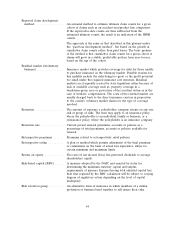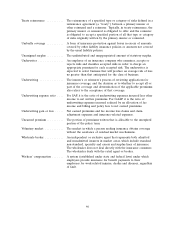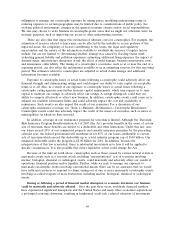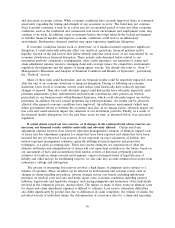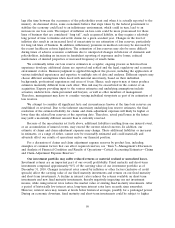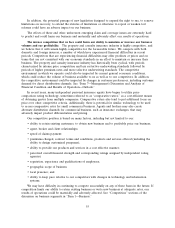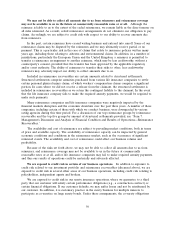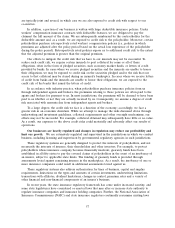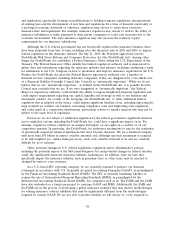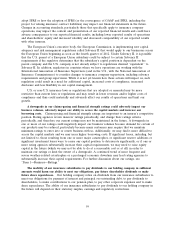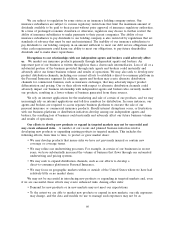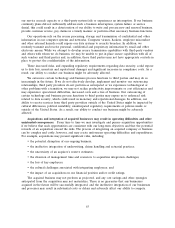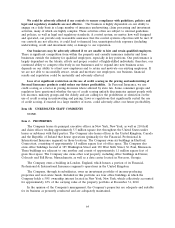Travelers 2010 Annual Report Download - page 66
Download and view the complete annual report
Please find page 66 of the 2010 Travelers annual report below. You can navigate through the pages in the report by either clicking on the pages listed below, or by using the keyword search tool below to find specific information within the annual report.See the ‘‘Asbestos Claims and Litigation’’ and ‘‘Environmental Claims and Litigation’’ sections of
‘‘Item 7—Management’s Discussion and Analysis of Financial Condition and Results of Operations.’’
Also see ‘‘Item 3—Legal Proceedings.’’
We are exposed to, and may face adverse developments involving, mass tort claims such as those
relating to exposure to potentially harmful products or substances. In addition to asbestos and
environmental claims, we face exposure to other types of mass tort claims, including claims related to
exposure to potentially harmful products or substances, including lead paint, silica and welding rod
fumes. Establishing claims and claim adjustment expense reserves for mass tort claims is subject to
uncertainties because of many factors, including expanded theories of liability, disputes concerning
medical causation with respect to certain diseases, geographical concentration of the lawsuits asserting
the claims and the potential for a large rise in the total number of claims without underlying
epidemiological developments suggesting an increase in disease rates. Moreover, evolving judicial
interpretations regarding the application of various tort theories and defenses, including application of
various theories of joint and several liabilities, as well as the application of insurance coverage to these
claims, make it difficult to estimate our ultimate liability for such claims.
Because of the uncertainties set forth above, additional liabilities may arise for amounts in excess
of the current related reserves. In addition, our estimate of claims and claim adjustment expenses may
change, and such change could be material. These additional liabilities or increases in estimates, or a
range of either, cannot now be reasonably estimated and could materially and adversely affect our
results of operations.
The effects of emerging claim and coverage issues on our business are uncertain. As industry
practices and legal, judicial, social and other environmental conditions change, unexpected and
unintended issues related to claim and coverage may emerge. These issues may adversely affect our
business by either extending coverage beyond our underwriting intent or by increasing the number or
size of claims. Examples of emerging claims and coverage issues include, but are not limited to:
• judicial expansion of policy coverage and the impact of new theories of liability;
• plaintiffs targeting property and casualty insurers, including us, in purported class action
litigation relating to claims-handling and other practices;
• claims relating to construction defects, which often present complex coverage and damage
valuation questions;
• claims under directors’ & officers’ insurance policies relating to: losses from involvement in
financial market activities, such as mortgage or financial product origination, distribution,
structuring or servicing and foreclosure procedures; fraud, including those related to investment
management businesses; possible accounting irregularities; and corporate governance issues;
• the assertion of ‘‘public nuisance’’ or similar theories of liability, pursuant to which plaintiffs
seek to recover monies spent to administer public health care programs; abate hazards to public
health and safety and/or recover damages purportedly attributable to a ‘‘public nuisance’’;
• medical developments that link health issues to particular causes, resulting in liability claims;
• claims relating to unanticipated consequences of current or new technologies; and
• claims relating to potentially changing climate conditions.
In some instances, these emerging issues may not become apparent for some time after we have
issued the affected insurance policies. As a result, the full extent of liability under our insurance
policies may not be known for many years after the policies are issued.
54


